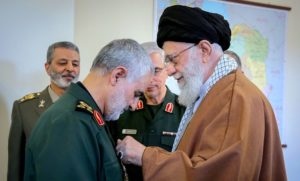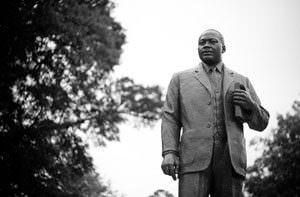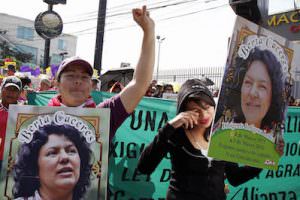The Mughniyeh Enigma
Imad Mughniyeh was once America's most-wanted terrorist, and his crimes were truly abhorrent. But his assassination, Ritter argues, will only lead to more violence.
Imad Mughniyeh is dead, killed in a Feb. 12 car bomb attack carried out by as yet unidentified assailants in a Damascus suburb. Mughniyeh, a Lebanese, had been the head of Hezbollah’s Jihad Council, responsible for the external operations of that organization’s military wing. He was 48 years old. Since coming into prominence during the bloody years of Lebanon’s civil war (1976-79), Mughniyeh had built a résumé of operations that, depending on one’s perspective, established him as either one of the world’s foremost terrorists or freedom fighters. Few outside Lebanon, Syria and Iran will regard him as anything other than a terrorist. He is alleged to have carried out numerous attacks against the United States, killing hundreds, but for me, a former Marine, it is the loss of 241 of my fellow servicemen, the majority of them Marines, in an attack on a Beirut barracks attributed to Mughniyeh that will forever cement him in my mind as a mortal enemy.
That Mughniyeh deserved what he got is, in my opinion, not a matter up for debate. When one lives by the sword, he should expect to perish in the same fashion. Mughniyeh is alleged to be the mastermind of a number of horrific attacks that killed hundreds of people, military and civilian alike. Some of his actions have been acknowledged by those who support him, such as the hijacking of TWA Flight 847 in 1985, which resulted in the murder of U.S. Navy diver Robert Stethem. Other alleged attacks, such as the bombing of the Israeli Embassy in Buenos Aires in 1992 and the bombing of a Jewish cultural center in Argentina two years later, have been denied by Hezbollah. Most recently, Hezbollah acknowledged that Mughniyeh had played a significant role in the summer 2006 border war with Israel; that conflict was initiated by an attack that he probably masterminded, an attack in which eight Israeli soldiers were killed and two others were abducted. There is no doubt that Mughniyeh was personally responsible for any number of attacks, acknowledged or not. Today Mughniyeh lies dead and buried in a land which continues to be torn asunder, largely because of the actions of men like him.
And yet anyone who thinks Mughniyeh’s demise somehow improves the overall situation in the Middle East is sadly mistaken. Hezbollah has appointed his successor, and in light of Hezbollah’s extensive experience and depth, whoever has taken the reins from the slain Mughniyeh will no doubt possess similar nefarious tenacity and imagination. As will whoever replaces the successor when he perishes, and on and on. As with the killing of al-Qaida’s purported No. 3, Abu Laith al-Libi, in Pakistan on Jan. 29 by a missile-equipped CIA unmanned drone, the impact of taking out one individual is minimized when the entire structure of the organization the individual served remains intact, and the cause of the organization, in the eyes of those who support it, remains just.
Indeed, as was so in both the Mughniyeh and al-Libi operations, the violent removal of an individual in isolation often does more harm than good, since it inflames tensions and undermines any progress toward a lasting resolution of the underlying problem. In the case of al-Libi, the CIA attack was conducted unilaterally over Pakistani airspace, without permission of the Pakistani government. This blatant violation of sovereignty by the United States could have detrimental ramifications well beyond any short-term benefit gained by killing al-Libi. And Mughniyeh’s assassination has incensed Hezbollah during a time of increased tension, raising the possibility of renewed conflict with Israel, a conflict that could easily spin out of control and spark an even larger regional conflict. While many tout such targeted killings as a critical element of any larger war on terror, the fact is such actions rarely succeed in facilitating an easing of terrorism, but rather accelerate and exacerbate the conditions that spawn it.
Radical Islamic fundamentalism of the sort that produces an Imad Mughniyeh is a nebulous entity lacking a central theme, cause, creed or motivating factor, save one: the lure of “martyrdom.” In most organizations, the elimination of a top leader would signal a setback, but the martyrdom of Mughniyeh simply motivates those who follow to stay the course. Those who wage jihad, or holy war, tend to view martyrdom not only as a risk worth taking but as a noble and just end in itself. As such, operations that kill jihadists like Mughniyeh, when viewed in isolation, are self-defeating. And if a policy countering the work of jihadists consists of little more than stringing together targeted assassinations, it is a policy doomed to fail.
The key to winning the so-called global war on terror hinges not on our ability to kill terrorists but rather our ability to create conditions that stop producing terrorists. History will show that the assassination of Mughniyeh produced far more terrorists, and far more terrorism, than if he had been left to live. Left to live, however, does not mean left alone. Any policy direction that de-emphasizes violence must articulate some sort of counter to the lure of jihad. There must be a policy of jihad de-legitimization. Unfortunately, the policies of the United States and Israel, in reacting to terror, have done more to legitimize jihad and the resultant acts of terror than anything else. An assassination not only energizes the base of a terrorist organization but, in the case of Mughniyeh, rallies to the cause of Hezbollah the fractured constituencies of global terror, the nebulous mafia of “radical Islamic fundamentalism” ignorantly referred to in certain circles as Islamofascism, that otherwise would have remained neutral or even in opposition.
Contrary to the statements of President George W. Bush and members of his administration, there is no global nexus of radical Islamic terror. There is a growing number of Islamic groups and organizations whose actions have become increasingly radicalized in the past decades, some of which have assumed tactics and methods that can be classified as terrorism. There will be those who will point out that Mughniyeh was in Damascus ostensibly to meet with Hamas leaders about a coordinated strategy for dealing with Israel and say that this, in fact, proves that Hezbollah and Hamas are working the same agenda. These same people will note that past statements made by senior al-Qaida figures, including Osama bin Laden, have praised the work of Hamas, and will conclude that Hamas and al-Qaida are working the same agenda. And some will note that bin Laden himself at one time opened a training camp for Shiite jihadists, thereby theoretically bringing Hezbollah and its Iranian masters (both exclusively Shiite entities) into line with al-Qaida (an exclusively Sunni establishment). But to claim that Hezbollah is Hamas, that Hamas is al-Qaida, and that al-Qaida is Hezbollah is wrong.Assessments of this sort put forth by the Bush administration and others fly in the face of reality and fact. Coordination between Sunni and Shiite is anathema for most Sunni fundamentalists, who view the Shiites as apostates; al-Qaida training literature places the Shiite as the second-greatest enemy of Islam, behind Sunni heretics, and ahead of Israel and the United States. Iran nearly fought a war with the Taliban and its al-Qaida allies in 1999, following the Taliban’s massacre of thousands of Shiite Hazara in Mazar-i-Sharif, Afghanistan, along with several Iranian diplomats and their families. Many of the more extreme elements within al-Qaida are known as “taqfiris,” or those who believe in the repudiation and elimination from Islam of all impure elements. To them, the Shiites are among the most impure. The natural inclination between Shiite and Sunni, especially at the level of fundamentalists, is to oppose one another, more often than not violently. The concept of a “nexus of terror” naturally linking these two forces together is difficult to imagine, let alone document. It would take a compelling cause for any such linkage to be formed, directly or indirectly. Such a cause exists, and it can be defined by one word: Palestine.
The cause of Palestine is not a natural rallying point for most Sunni fundamentalists associated with al-Qaida. For all the language of global jihad, most Sunni fundamentalists are in fact quite parochial, focused primarily on “cleansing” Islam only insofar as it impacts them personally. Thus, an Egyptian member of the Muslim Brotherhood is almost exclusively focused on ridding Egypt of “heretics” such as President Hosni Mubarak, and not supporting global jihad or the Palestinian cause. Similarly, Sunni fundamentalists in Afghanistan are more concerned with establishing Islamic purity in their respective areas than they are with exporting Islam abroad. While there are those elements of Sunni Islamic fundamentalism that do in fact espouse global jihad, they are very much in the minority and, more critically, isolated from any traditional foundation of support. Stateless, these extremists are prone to being isolated from the rest of Islam due to a combination of conditions — their inability to bond with the natural fabric of Islamic society (family, tribe and nation), and the violence of their actions, which are rejected by nearly the entire Islamic world. These stateless jihadists are in fact little more than parasites, and they require a host cause from which they can nourish. Palestine represents such a cause.
One of bin Laden’s overarching objectives was to get the United States to commit to a course of action that pitted it in a life-and-death struggle with Islam. The horrific attacks of Sept. 11, 2001, were intended to accomplish this, but in fact backfired when the majority of Islam expressed revulsion at the murder of thousands of innocents. It took the invasion of Iraq by the United States to breathe life into bin Laden’s dream. Afghanistan today remains a remote battleground in the “global war on terror,” with American forces engaged in little more than a fruitless manhunt amid the backdrop of an internal struggle for power within Afghanistan and Pakistan. The American invasion of Iraq created the spectacle of a Christian nation invading and occupying, in brutal fashion, a Muslim people (albeit ruled by a secular dictator). But even this horrific blunder by the United States, left in isolation, was not enough to inspire a universal condemnation by the Islamic world, if for no other reason than that the Iraqi regime of Saddam Hussein was viewed by most Muslim nations as an embarrassment. The resistance to the American occupation of Iraq comes almost exclusively from Iraqi sources, with foreign jihadists comprising a distinct minority used more as disposable munitions (i.e., suicide bombers) than a philosophical center of gravity. But what the American invasion of Iraq did accomplish, coupled with the ongoing occupation of Afghanistan, was to create the impression of a larger struggle between the West and Islam that has come to be defined by a separate ongoing occupation, carried out by an American ally viewed by many in the Muslim world as more U.S. proxy than U.S. friend. The occupier in this case is Israel, with Palestine being the occupied territory. Since 9/11 didn’t capture the imagination of the Muslim world, and Afghanistan and Iraq couldn’t hold the attention of the Muslim world, bin Laden and his circle of followers have opportunistically picked up on Palestine as the issue of the moment. Unlike 9/11 and Iraq, it’s an issue that sticks.
Hamas rejects any effort to label its movement as extremist, and, though it is a religious organization, it has vociferously rebuffed all efforts undertaken by al-Qaida to piggyback the cause of global jihad onto the matter of a Palestinian homeland. Hamas chief Khaled Meshaal has repeatedly underscored that his group’s mission is to secure a Palestinian homeland and that its military struggle will never expand beyond confronting Israel inside Israel or in the occupied territories. While Hamas has no global agenda, it has attracted the attention of Islamist elements around the world beyond the parasitic opportunism of al-Qaida, including Hezbollah, the parent organization of Imad Mughniyeh.
Hezbollah began as a radical outgrowth of the Lebanese Shiite militia group known as Amal. In 1979, following the Islamic Revolution in Iran, radical elements of the newly formed Iranian Revolutionary Guard Command traveled to Lebanon in an effort to export the concept of Islamic revolution. Many of these Iranians took Lebanese wives and became an integral part of the Shiites of southern Lebanon and the Bekaa Valley. The call for Islamic revolution did not catch on, however, and many of the original cadres of Revolutionary Guards were transferred back to Iran when Iraq invaded. The Israeli invasion and occupation of southern Lebanon in 1982 dramatically altered the political landscape among the Shiites. The Iranians rushed reinforcements to Lebanon to support their Amal allies, until nearly 1,500 Revolutionary Guards were deployed. These forces helped fight the Israeli army to a standstill, and became a critical part of the resistance movement that grew inside Lebanon. Mughniyeh came into prominence during this time, serving as a senior leader of a group known as Islamic Jihad. Under his direction, some 35 suicide attacks were launched against the forces of those nations seen as occupiers of Lebanon, including Israel and, later, the United States and France. By 1985, differences in the direction of resistance to the ongoing Israeli occupation had created a split within the Shiites of southern Lebanon, with the mainstream Amal militia taking a more moderate approach and a more radical wing of Amal, backed by the Revolutionary Guard, advocating a more aggressive stance. The radicals split from Amal in 1985 and created their own organization, known as the Party of God, or Hezbollah. Although Lebanese, Hezbollah, as a Shiite-based religious organization, recognized the supreme leader of Iran as its highest political authority and looked to Tehran for final approval of most major decisions. With the death of the Ayatollah Khomeini in 1989, Hezbollah increasingly assumed a more independent posture, although it remained strongly influenced by Iran. Hezbollah had an almost singular focus on achieving the liberation of Lebanon from Israeli occupation, a goal it was surprisingly able to achieve in 2000 through tenacity and the force of arms.
Links between Hezbollah and Hamas were for all intents and purposes nonexistent before 2002. When Israeli forces raided the West Bank and detained Marwan Barghouti, a prominent Palestinian figure, Hezbollah head Hasan Nasrullah expressed his support of Palestinian resistance to an Israeli occupation of Palestine, which he felt paralleled the Israeli occupation of Lebanon. Barghouti headed a wing of the PLO known as Tanzim. Tanzim had become a very effective and violent movement resisting Israel and was gradually drifting away from embracing what it viewed as the more accommodating policies of the PLO and toward the more active resistance embraced by Hamas. When Israel assassinated the former head of Hamas, Sheikh Ahmad Yassin, in 2004, Nasrullah publicly declared the forces of Hezbollah to be at the disposal of Hamas.
But Hamas continues to maintain that it will limit its actions to the immediate theater of action in Israel and the occupied territories, and Hezbollah maintains that its military operations will be limited to protecting Lebanon from outside aggression and Israeli occupation. In 2004, the same year he promised support for Hamas, Nasrullah declared that any solution to the Palestinian problem that was acceptable to the Palestinians would be acceptable to Hezbollah. Far from embracing Osama bin Laden’s parasitic cry for global jihad in defense of Palestine, both Hamas and Hezbollah recognized the reality of Israel as a nation-state and were willing to deal with Israel within the context of the pre-1967 borders and respect for the rights of Palestinians. This posture seemed to be embraced by Hezbollah’s Iranian sponsors as well, insofar as a 2003 diplomatic outreach from Iran to the United States indicated both a willingness to respect Israel’s legitimate right to exist as a nation-state and a promise to help rein in the actions of Hezbollah and Hamas.
The rejection by the Bush administration of the 2003 Iranian initiative, Israel’s disastrous 34-day war with Hezbollah in the summer of 2006 and Israel’s virtual declaration of war against Hamas have combined to negatively influenced the situation vis-à-vis Israel, Palestine, Hamas, Hezbollah and Iran. The policies of the Bush administration — from opposing a cease-fire in Lebanon in 2006 while a thousand Lebanese civilians were being bombed to death by Israel and over a hundred Israelis, mostly soldiers, were being killed by Hezbollah, to promoting a confrontational policy centered on regime change with Iran — have only exacerbated an already difficult situation. The assassination of Imad Mughniyeh, which, despite denials, might have been a direct action undertaken by the Israeli Mossad, threatens to turn a volatile situation into an explosive one. If Hezbollah carries out its promise of retaliation against Israel, the northern border of Israel could again explode in violence that, this time, might extend all the way to Iran, drawing in the U.S. military as well. The end result would be further radicalization of forces like Hamas and Hezbollah, as well as Iran, and the creation of a casus belli for radical Islamic fundamentalists worldwide, many of whom will be drawn in by the opportunistic calls for jihad issued by bin Laden and other al-Qaida leaders; in short, a victory for radical Islamic fundamentalism.
This is a fight that didn’t need to happen, and should never have been allowed to develop in this manner. Whatever Mughniyeh had done in the past, the fact is that for more than a decade this “world’s most dangerous man” had been contained by the passage of time. The events that created a Mughniyeh in Lebanon were no longer in play, and his role in the greater scheme of things had been significantly reduced. Simply put, Mughniyeh was no longer a key player for Hezbollah or any other group, and was fully subject to being contained by those elements that favored moderation and diplomacy over extremism and violence. Now he is dead, and there is the great possibility of even more violence being done in the name of a man who was, for the most part, a vestige of times gone by, and no longer relevant.
This is the Mughniyeh Enigma. Do we hold on to the events of the past, seeking to avenge all wrongs regardless of the consequences? Did Mughniyeh deserve to be brought to justice? Yes. Was justice served by assassinating him? No. The only thing accomplished was a simple act of revenge that no court of law would recognize as justice. If the issue of greater good, especially within the context of the “global war on terror,” is considered, it becomes clear that by far the greater good would have been served by letting Mughniyeh be and allowing his enemies to focus on the issue that exacerbates all efforts to quash radical Islamic extremism, whether it is derived from a parasitic organization like al-Qaida or from regional resistance-oriented groups like Hamas and Hezbollah: Palestine. Resolving the Palestinian issue would not cure all that ails the Middle East. But it would go a long way in restoring a sense of stability, a foundation of peace upon which any lasting agreement between Israel and its neighbors, or for that matter the United States and the Middle East, might be built.
Your support matters…Independent journalism is under threat and overshadowed by heavily funded mainstream media.
You can help level the playing field. Become a member.
Your tax-deductible contribution keeps us digging beneath the headlines to give you thought-provoking, investigative reporting and analysis that unearths what's really happening- without compromise.
Give today to support our courageous, independent journalists.





You need to be a supporter to comment.
There are currently no responses to this article.
Be the first to respond.